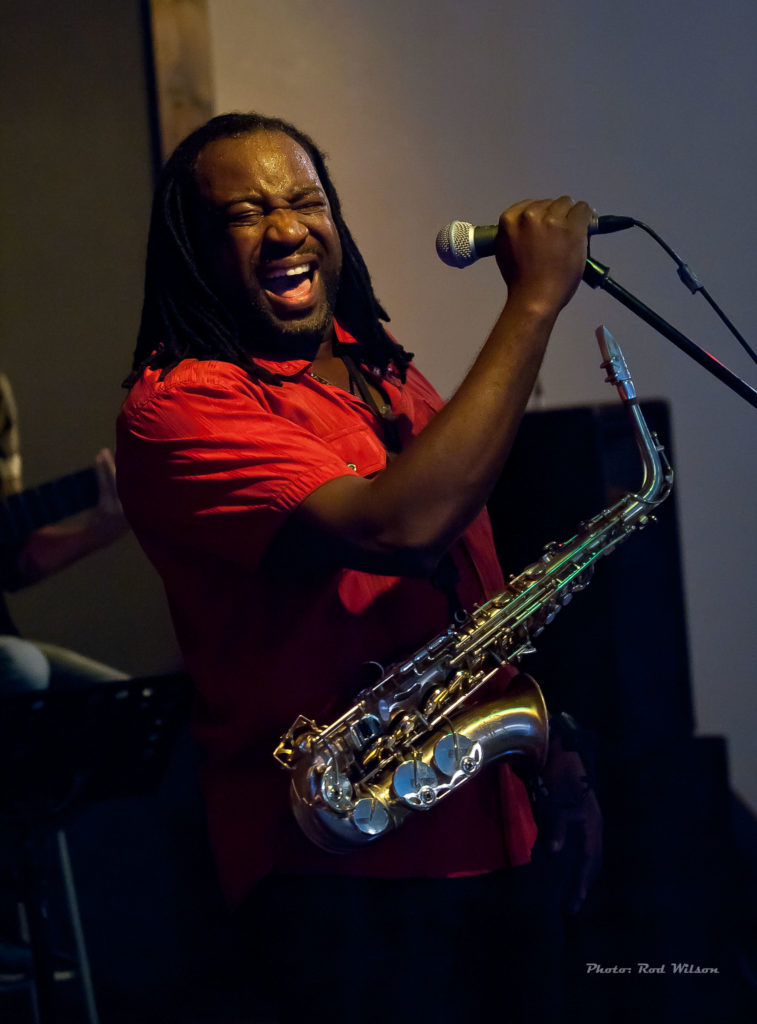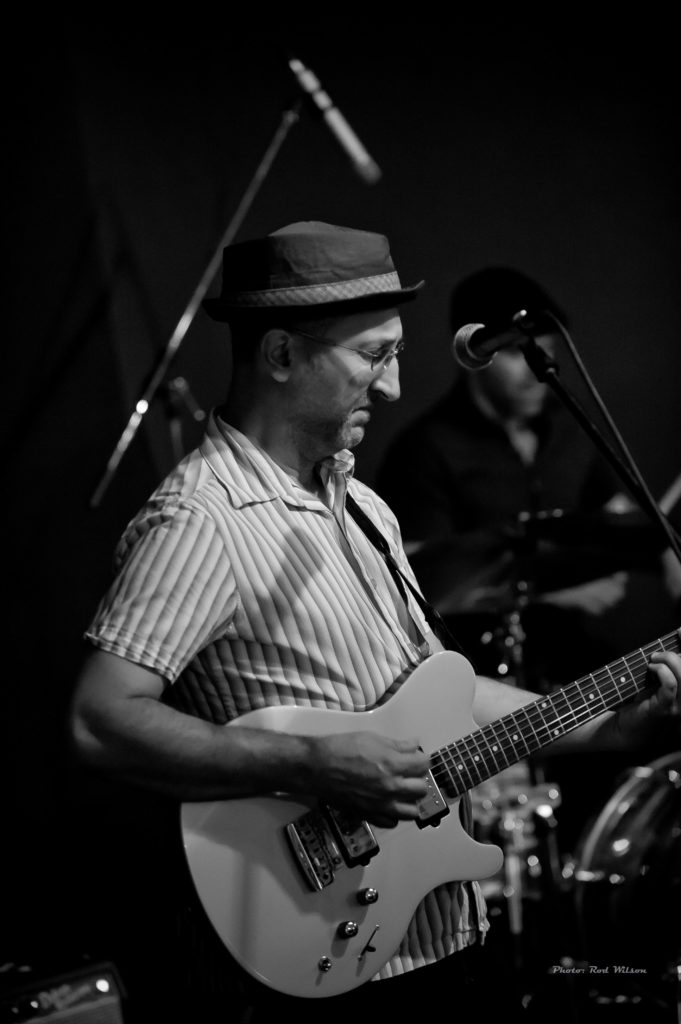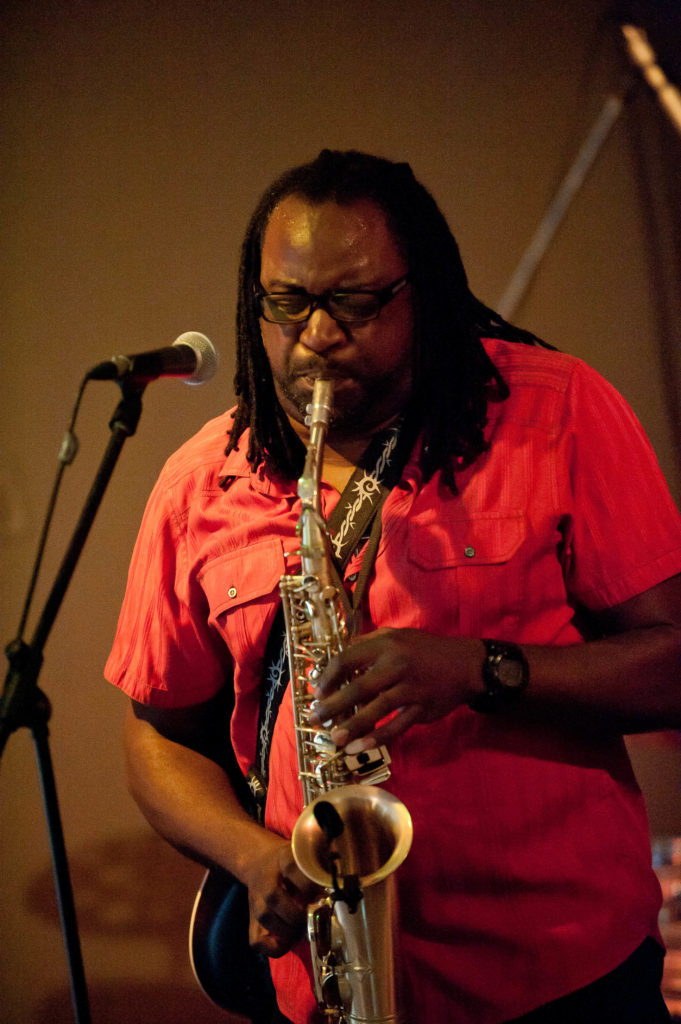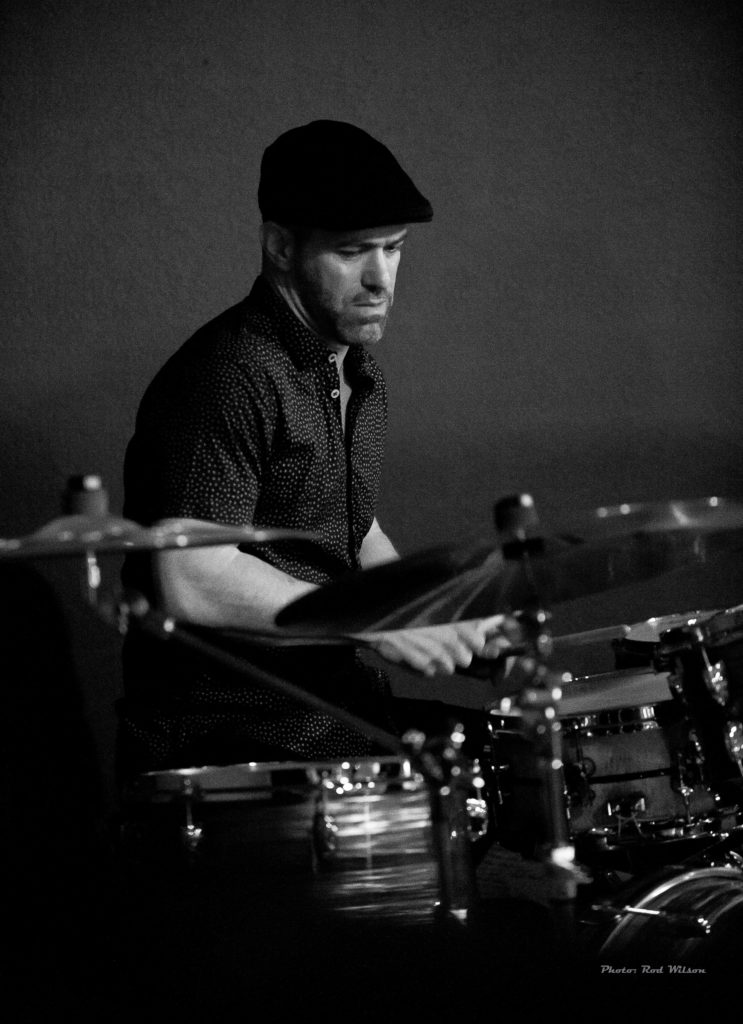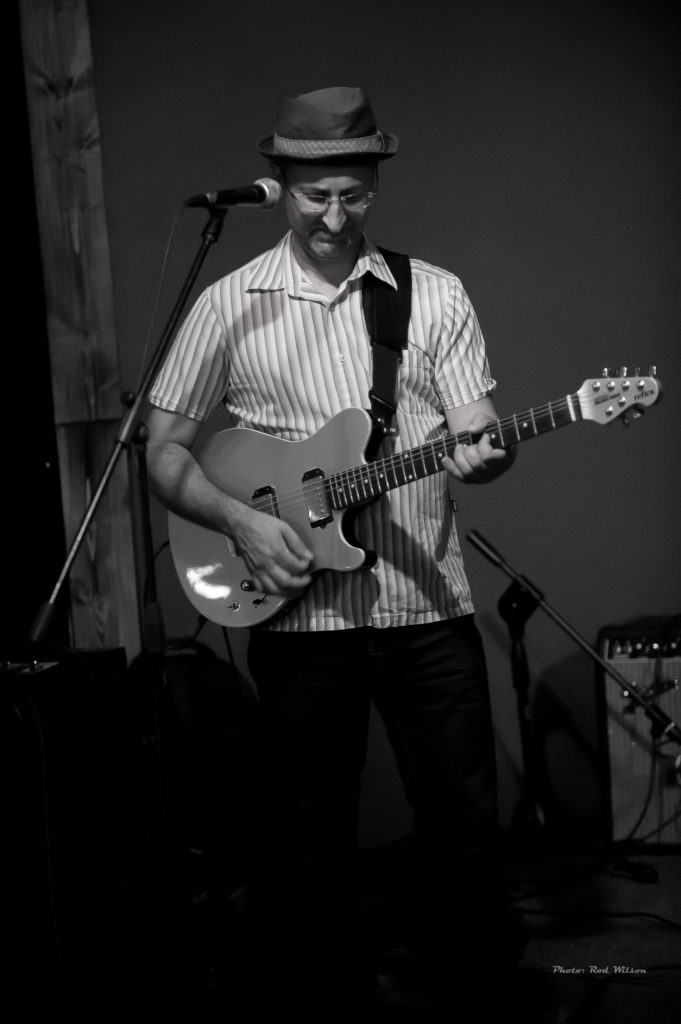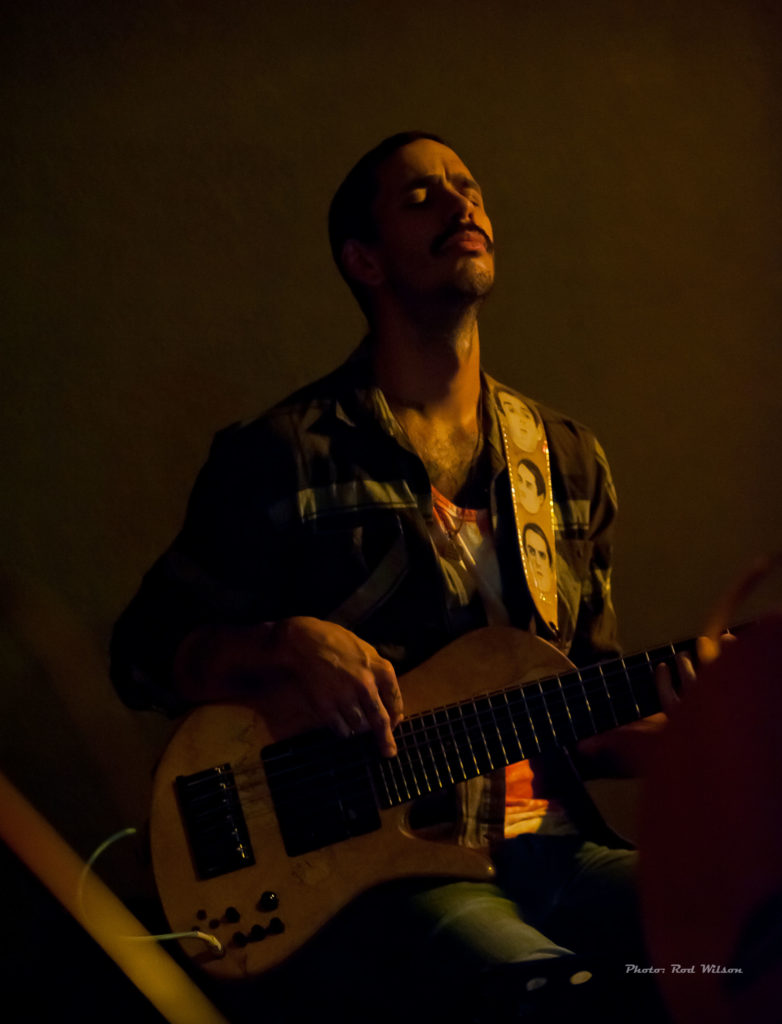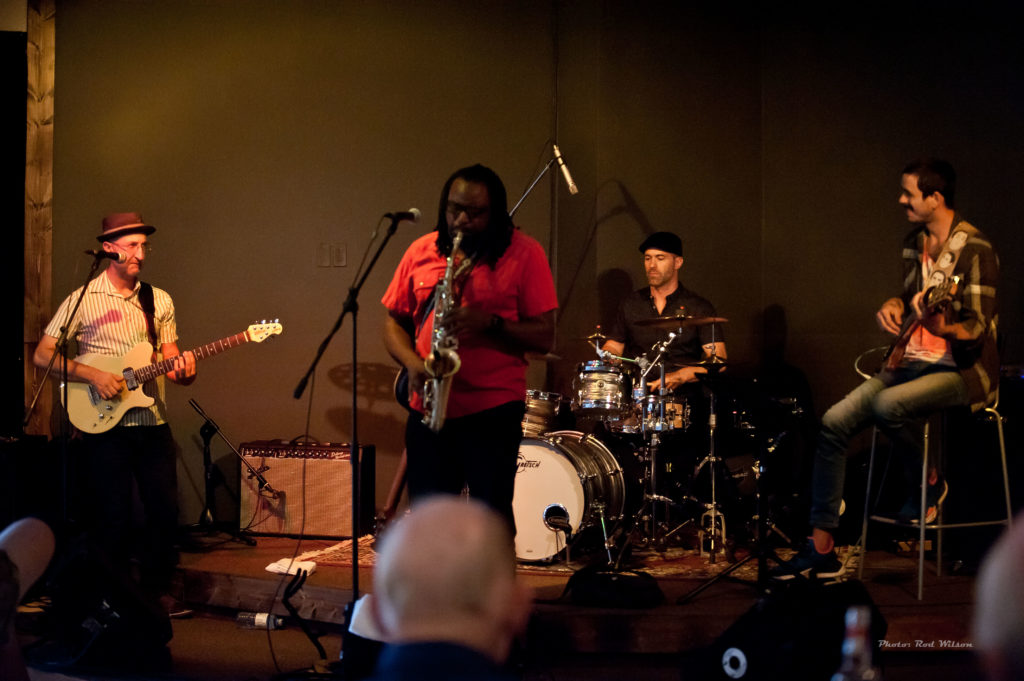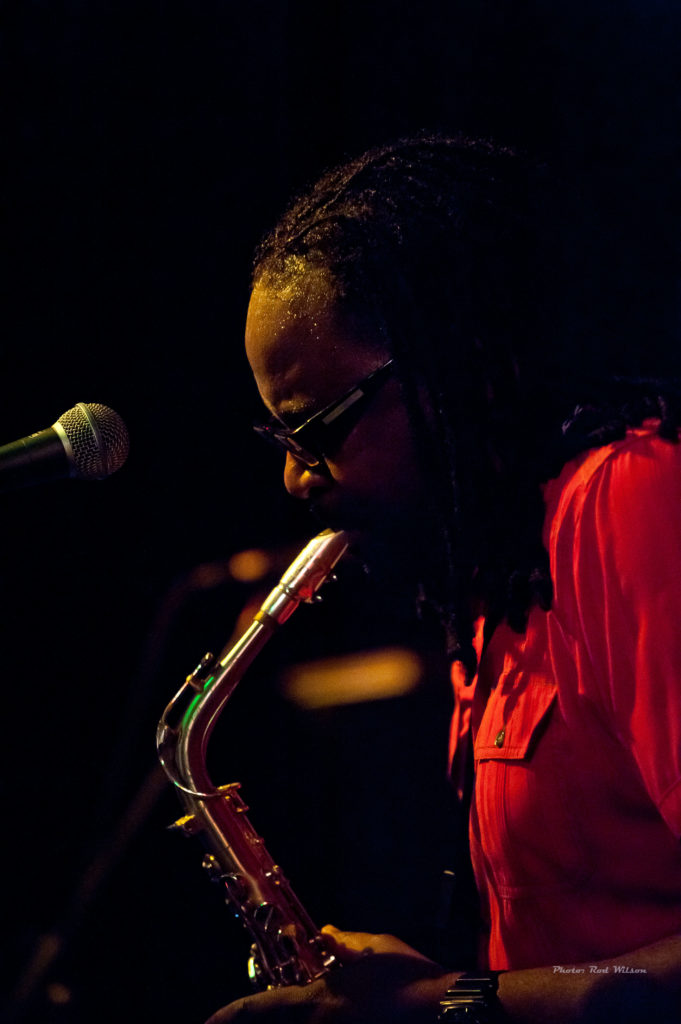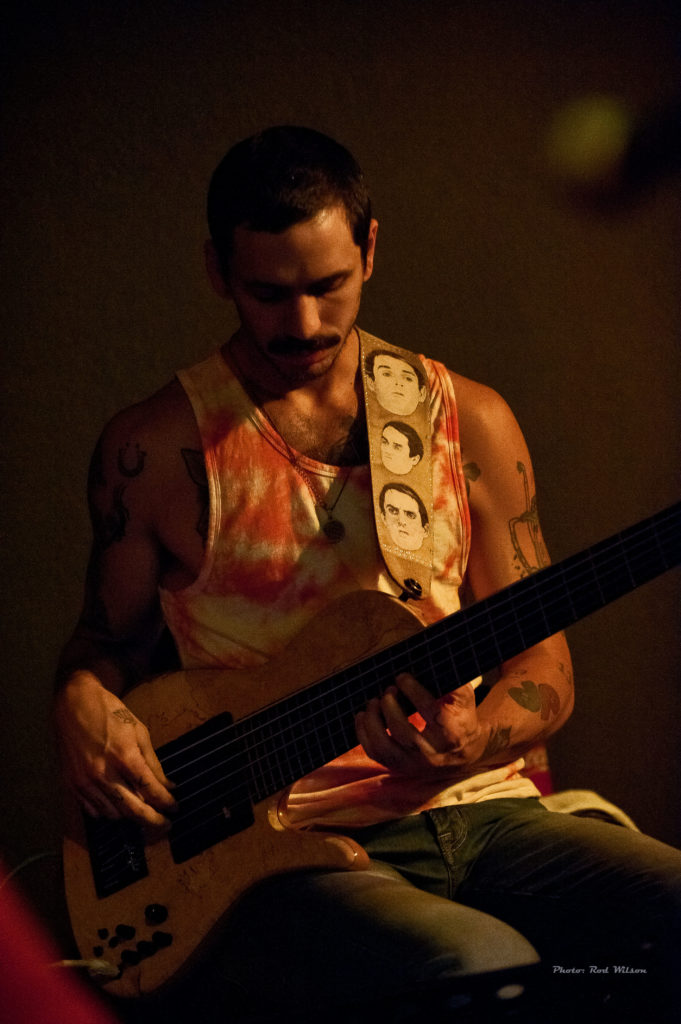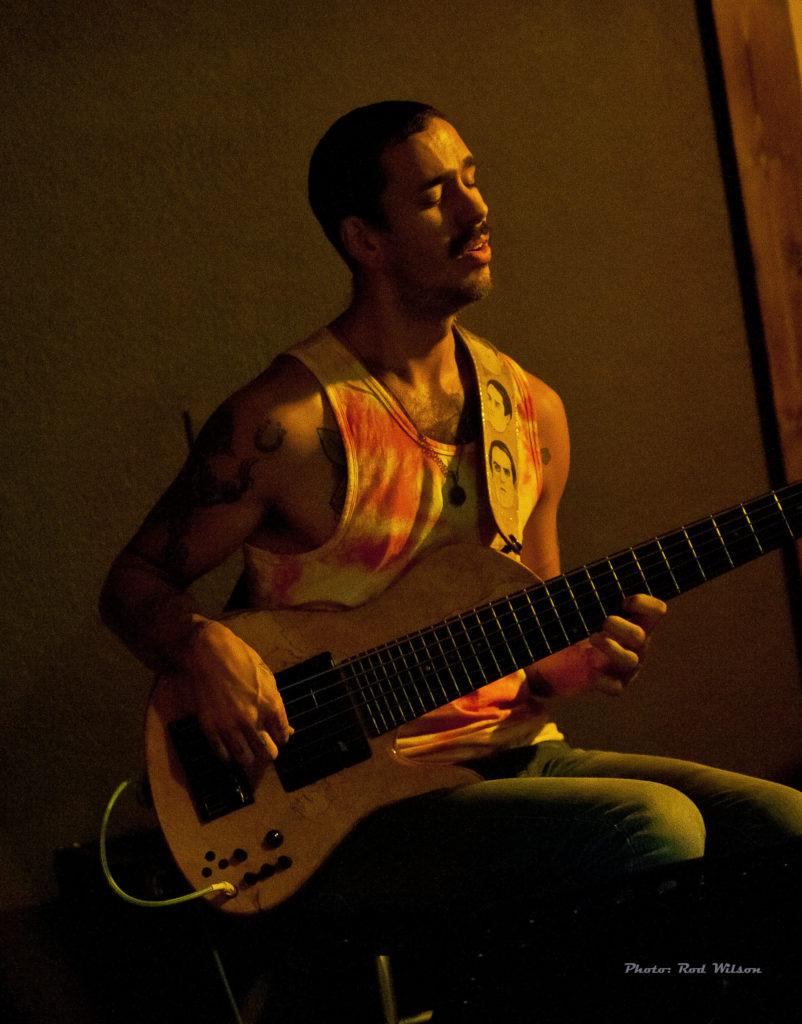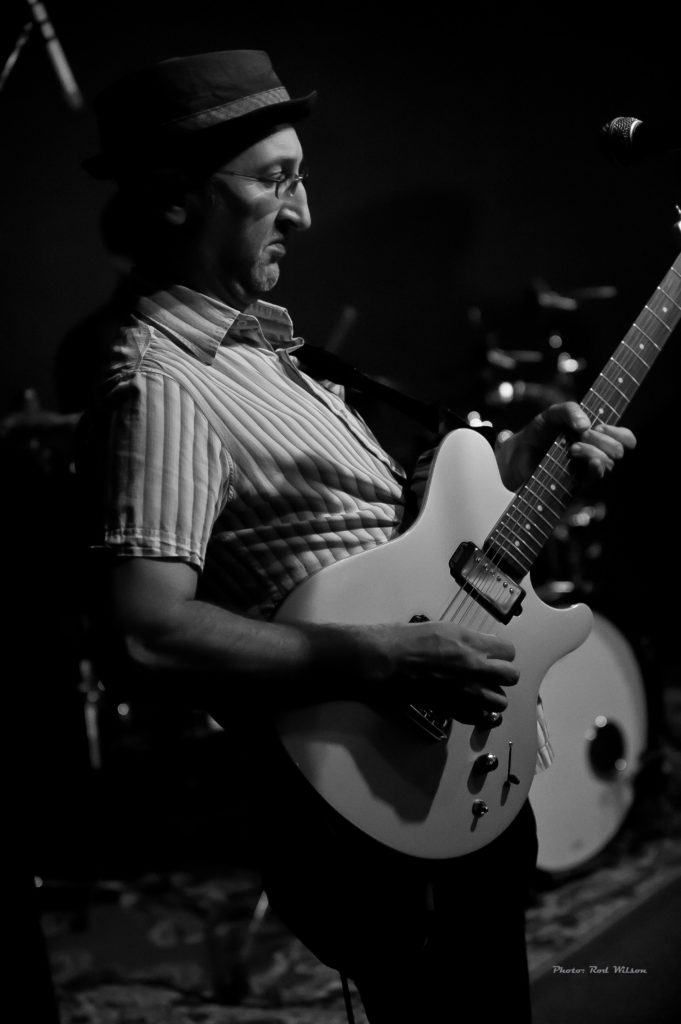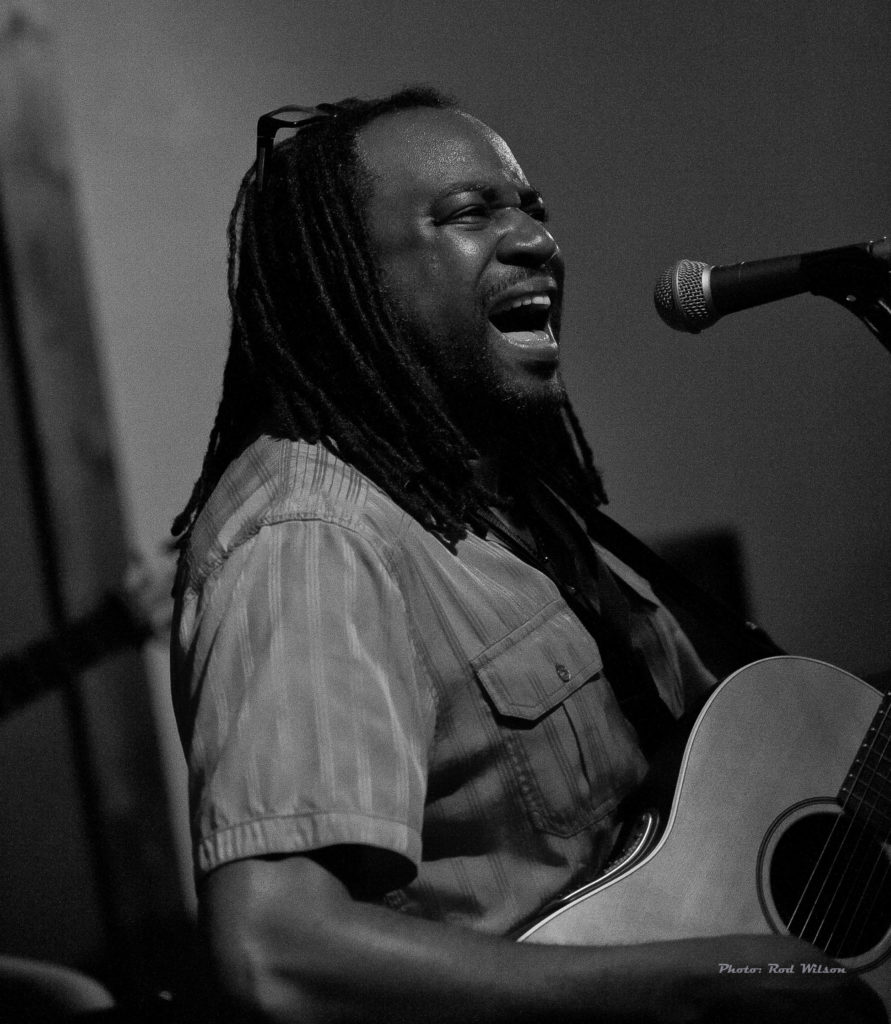If you looking for a YouTube performance by John Dowland (1563-1626) then you are out of luck. He died about 400 years ago. That was way back at the end of the first Elizabethan era. Despite his demise his music lives on and is a staple in the Classical Guitar, Lute and Vocal repertoires of today. He was an English Renaissance composer and lutenist and in his day was described as “the rarest musician that his age did behold’. He was a celebrated composer and performer who traveled extensively in Europe. He constantly fell afoul of the religious turmoil of the day. He was Catholic and despite his fame was unable to obtain a court position with Protestant Elizabeth I. He finally, and belatedly, obtained a position with King James I. At that time he was recognized as the finest Lutenist in Europe. He is best known today for his melancholy songs such as Come, Heavy Sleep (the basis of Benjamin Britten’s 1963 composition for solo guitar Nocturnal after John Dowland ) Come Again, Flow my Tears, I saw my Lady Weepe and In Darkness let me Dwell. As the titles suggest his music displays the melancholia that was so fashionable in his day. His instrumental music has undergone a revival and today any serious Guitarist or Lutenist needs to spend serious time in exploring the music of John Dowland. The music is complex, exciting and well worth the effort.
I recently stumbled on a YouTube vocal performance of Come Again by the Bensa-Cardinot Duo and it was one of those “ah ha” moments. Cécile Cardinot vocals had a purity that “rocked my world”. I don’t know if was her French accent or the old English language that ignited my imagination. The first video features Cecile on vocals and Olivier Bensa on Lute. In the second video Olivier switches to Classical guitar.
COME AGAIN – Lyrics (not the same as Cecile’s)
Sweet love doth now invite
Thy graces that refrain
To do me due delight
To see, to hear
To touch, to kiss
To die with thee again
In sweetest sympathy
Come again
That I may cease to mourn
Through thy unkind disdain
For now left and forlorn
I sit, I sigh
I weep, I faint
I die, in deadly pain
And endless misery
Gentle love
Draw forth thy wounding dart:
Thou canst not pierce her heart;
For I that do approve
By sighs an d tears
More hot than are
Thy shafts, did tempt while she
For scanty tryumphs laughs
Born in 1989 in France, Cécile Cardinot is a singer, a spectacular classical guitarist and choirmaster. She started her guitar career with Olivier Bensa in 2008. Along with her choirs, concerts that lead her to various countries and her profession as a guitar teacher at Cahors Conservatory, she worked on the music of John Dowland to create a show “Voice Lute Forte” dedicated to the music of this composer. She is laureate of the Claude Nougaro competition as well as “Revelation Guitarist Acoustic” 2015. (check the duo’s performance of Piazolla’s Libertango to gain an appreciation of her guitar skills http://www.rodneywilson.ca/2018/07/10/youtube-pick-26-nuevo-tango-new-tango/ )
Her musical colleague Olivier Bensa was born in 1951, is a classical guitarist, lutenist and composer. He has recorded several discs such us “O. Bensa performs Leo Brouwer”, appointed as a reference by the composer himself. Being a concert performer, he has played in prestigious halls (Gaveau in Paris, Wigmore Hall in London…). As a composer he is subject to numerous commands and his works for guitar are published at H. Lemoine Editions. In 2016 he worked with Cécile to create Voice Lute Forte a work dedicated to English Renaissance music and more specifically to the music of John Dowland.
@@@@@@@@@@@@
Here is another version with the lyrics closer to those printed above
https://www.youtube.com/watch?v=Bg30Gf_6izc
@@@@@@@@@@@@
The flip side of John Dowland’s Music is his instrumental music and specifically his Lute music. Here is a performance of his Fantasia No.7 by Andrey Lebedev .It starts out as a gentle, stately exploration of the melody before going into complex variations and contrapuntal explorations before reaching a climax in an eighth rhythm finale. Modern day steel string guitar players with their alternate tuning and finger picking techniques have been heading in this direction for a number of year but, take note, John Dowland was there long before us. A technical note: To emulate the sound and range of the Lute, modern day classical guitarists will use a capo (usually at the third fret) and tune the G string down to F#.
Andrey Lebedev, born in Moscow and raised in Australia is one of many, many outstanding young players who are breathing new life into Classical Guitar performances. He is a winner of many awards and honors and currently lives in London where he is a full scholarship student at the Royal Academy of Music, supported by the ABRSM and the Julian Bream Trust. His interests in contemporary repertoire have led him to premiere new works by leading composers including Peter Sculthorpe’s Oh T.I. for Guitar and String Orchestra, Leo Brouwer’s Danzas Rituales y Festivas, Vol.2 and the aforementioned Julian Bream Trust commissions, as well as regularly performing music by late 20th century by composers such as Berio, Henze, Ginastera, Britten and Takemitsu. A lover of chamber music, Andrey Lebedev performs regularly with flautists Bronte Hudnott and Alena Lugovkina, mezzo-soprano Lotte Betts-Dean, and has worked extensively with the Llewelyn Guitar Quartet in Australia.
@@@@@@@@@@@@
Post Script: – 2018/10/29 – The music of John Dowland has even penetrated the consciousness of the rock world. I came across these two videos of Sting with Lutenist Edin Karamazov performing a number of John Dowland songs. I have always enjoyed Stings musical exploration in rock, world music, jazz and solo performances but even I was surprised by these forays into the songs of John Dowland.
The instrument Sting is playing is called a Theorbo. It is a plucked string instrument of the lute family family with an extended neck and a second pegbox.
@@@@@@@@@@@@


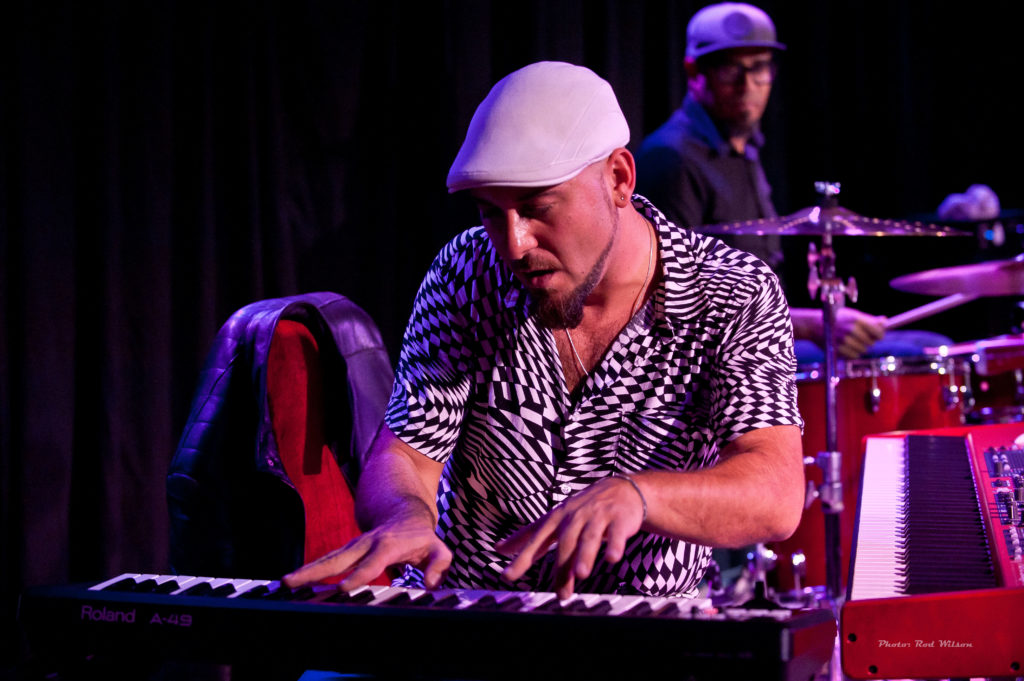 production of his first solo album “Diario de Viaje” (Travel Diary) in 2010. The album received critical acclaim from music industry journals, and was chosen as one of the best Latin Jazz albums of the year by JAZZ FM Toronto. He went on to record a further 3 albums that cemented his unique sound, culminating in his 4th and latest album, “Made in Canada” (2017), which also happens to be his first live recording. Gabriel’s songs are a representation of the many cultures which have influenced his music over the years, with a deep core in Latin Jazz.
production of his first solo album “Diario de Viaje” (Travel Diary) in 2010. The album received critical acclaim from music industry journals, and was chosen as one of the best Latin Jazz albums of the year by JAZZ FM Toronto. He went on to record a further 3 albums that cemented his unique sound, culminating in his 4th and latest album, “Made in Canada” (2017), which also happens to be his first live recording. Gabriel’s songs are a representation of the many cultures which have influenced his music over the years, with a deep core in Latin Jazz. Doug Stephenson on bass and Tony Ferraro on drums for a collection of some familiar material (Juan Tizol’s Caravan and Ahmad Jamal’s Poinciana) along with his original compositions. This time around the other members of the trio were Cameron Hood from Vancouver on 6 string Tobias electric bass and Luis “El Pana” Tovar on drums. Luis is originally from Venezuela and is now a resident of Calgary. The program for the evening was all original material. As can be imaged, rehearsing such a scattered group of musicians is a challenge. It was done by exchanging mp3’s across continents followed by only three days of rehearsals before the tour. Cameron assures me that the music is fiendishly difficult and for him to nail the exotic piece “in sevens” required many hours of solo practice. Cameron explained that the piece was in 7/8 (perhaps a nod to Gabriel’s Turkish roots) but it was complicated by mirror images of the rhythm. 123 4567 followed by 1234 567 – three and four followed by four and three. On top of that there was all the salsa, Latin and funk overtones. I confess as an Anglo the names of all the Spanish tunes just flew by me. “Oh yeah. There was that thing in sevens. Then there was the Flamenco piano piece and the piece with fragments of Astor Piazolla’s Libertango but as to the names of the tunes they just flew by”. No matter. The music was a tour de force of Latin, Funk and not to be forgotten Nuevo Tango.
Doug Stephenson on bass and Tony Ferraro on drums for a collection of some familiar material (Juan Tizol’s Caravan and Ahmad Jamal’s Poinciana) along with his original compositions. This time around the other members of the trio were Cameron Hood from Vancouver on 6 string Tobias electric bass and Luis “El Pana” Tovar on drums. Luis is originally from Venezuela and is now a resident of Calgary. The program for the evening was all original material. As can be imaged, rehearsing such a scattered group of musicians is a challenge. It was done by exchanging mp3’s across continents followed by only three days of rehearsals before the tour. Cameron assures me that the music is fiendishly difficult and for him to nail the exotic piece “in sevens” required many hours of solo practice. Cameron explained that the piece was in 7/8 (perhaps a nod to Gabriel’s Turkish roots) but it was complicated by mirror images of the rhythm. 123 4567 followed by 1234 567 – three and four followed by four and three. On top of that there was all the salsa, Latin and funk overtones. I confess as an Anglo the names of all the Spanish tunes just flew by me. “Oh yeah. There was that thing in sevens. Then there was the Flamenco piano piece and the piece with fragments of Astor Piazolla’s Libertango but as to the names of the tunes they just flew by”. No matter. The music was a tour de force of Latin, Funk and not to be forgotten Nuevo Tango.
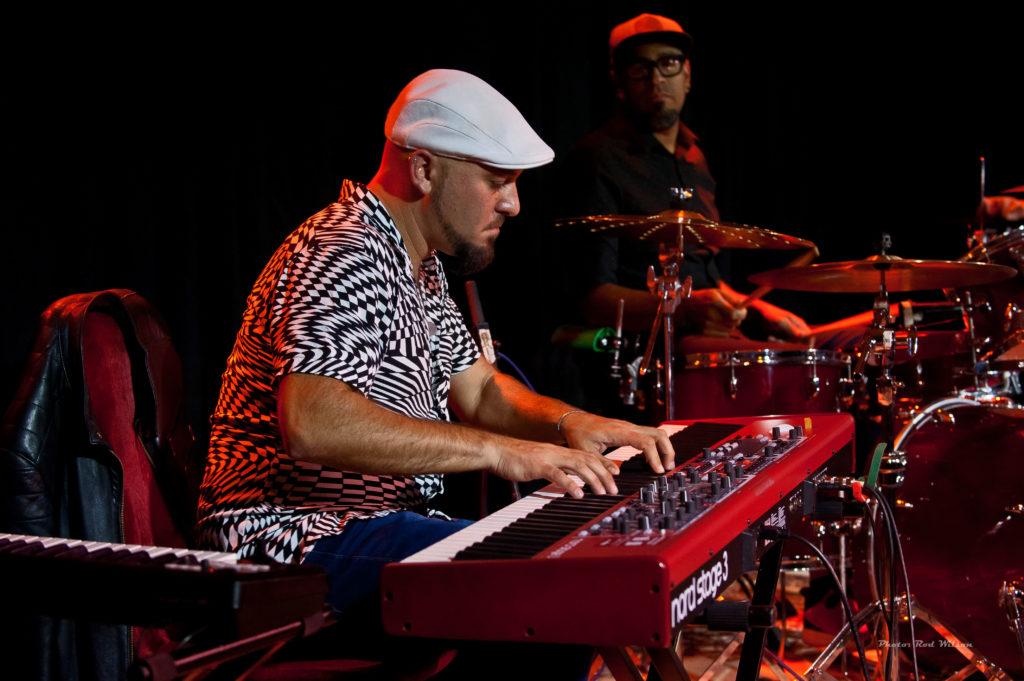

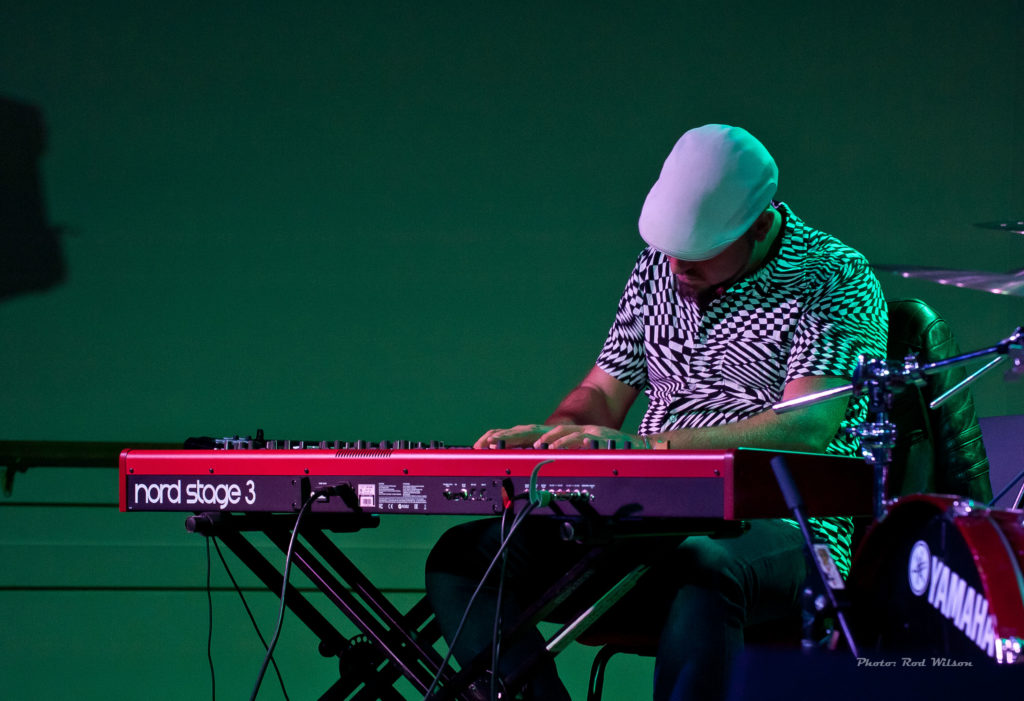
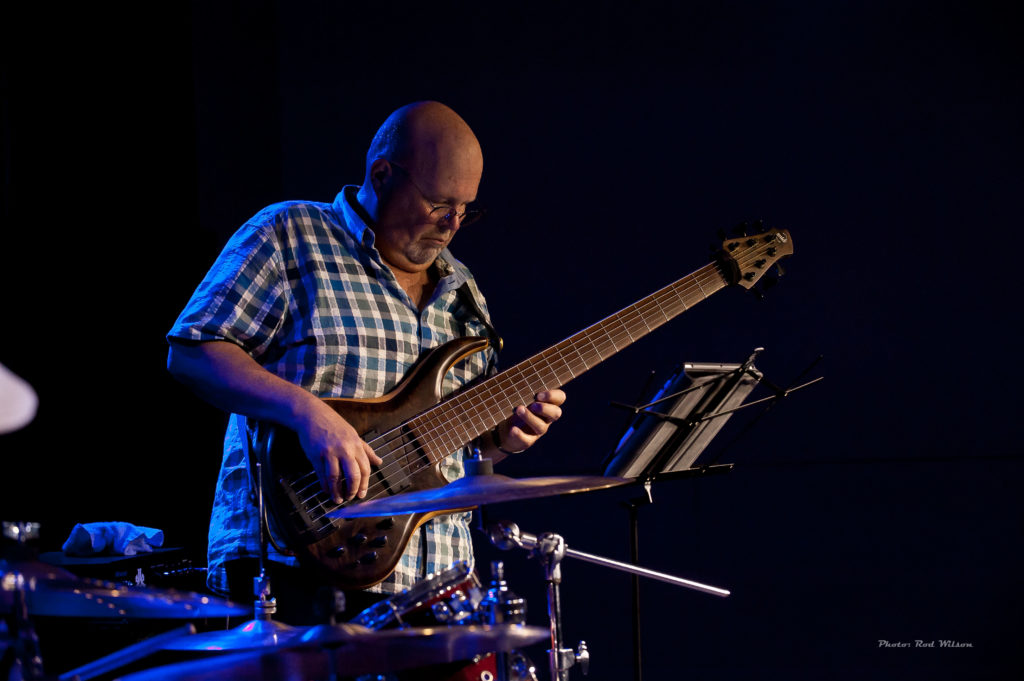

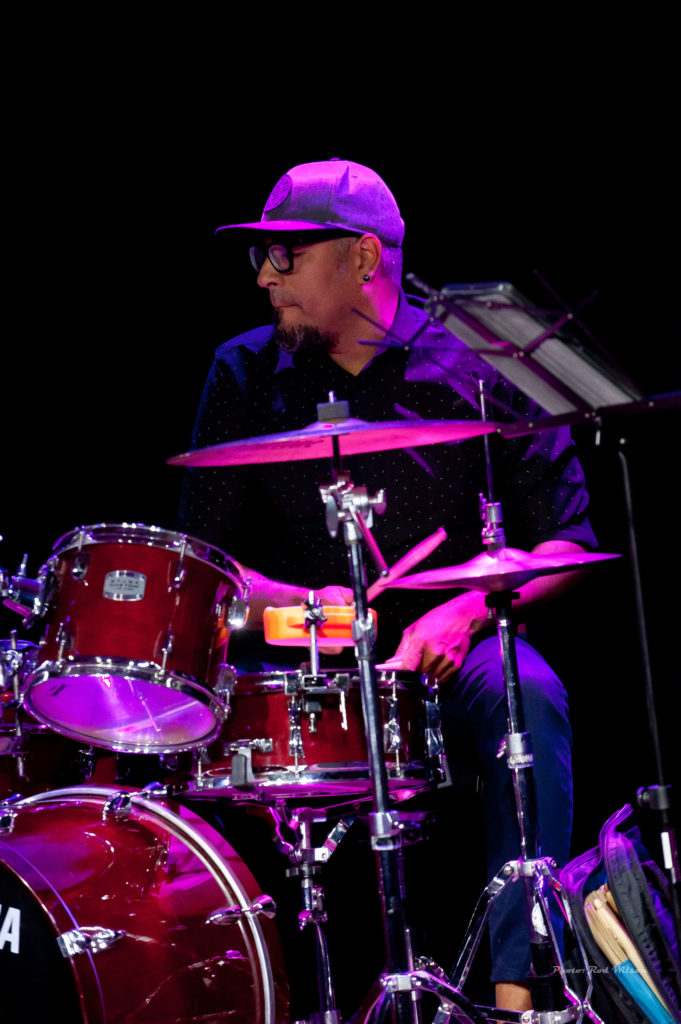
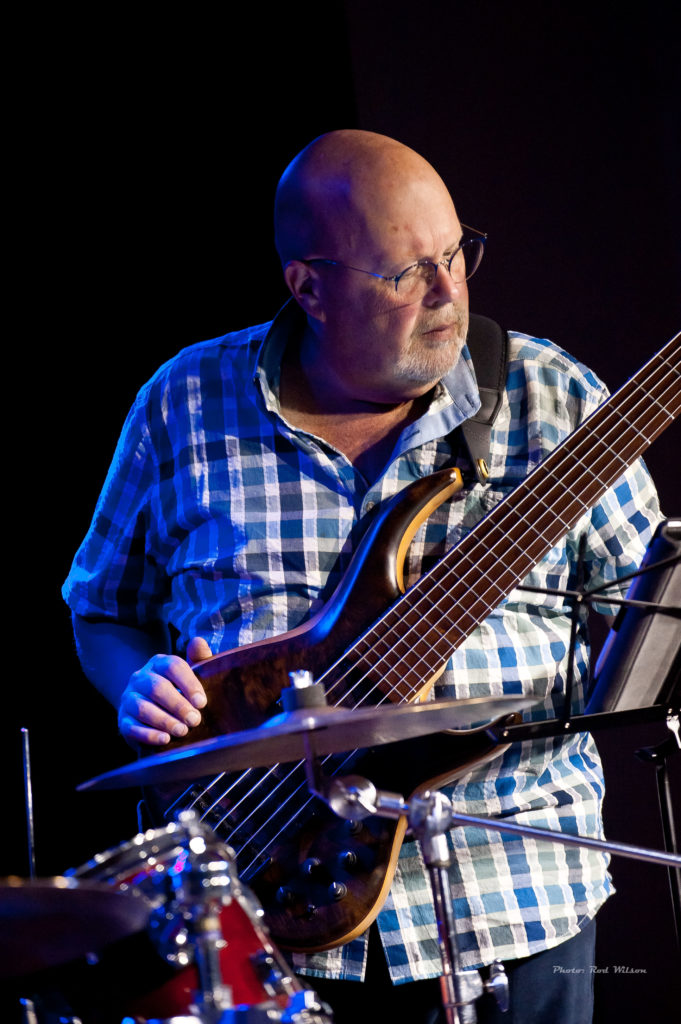
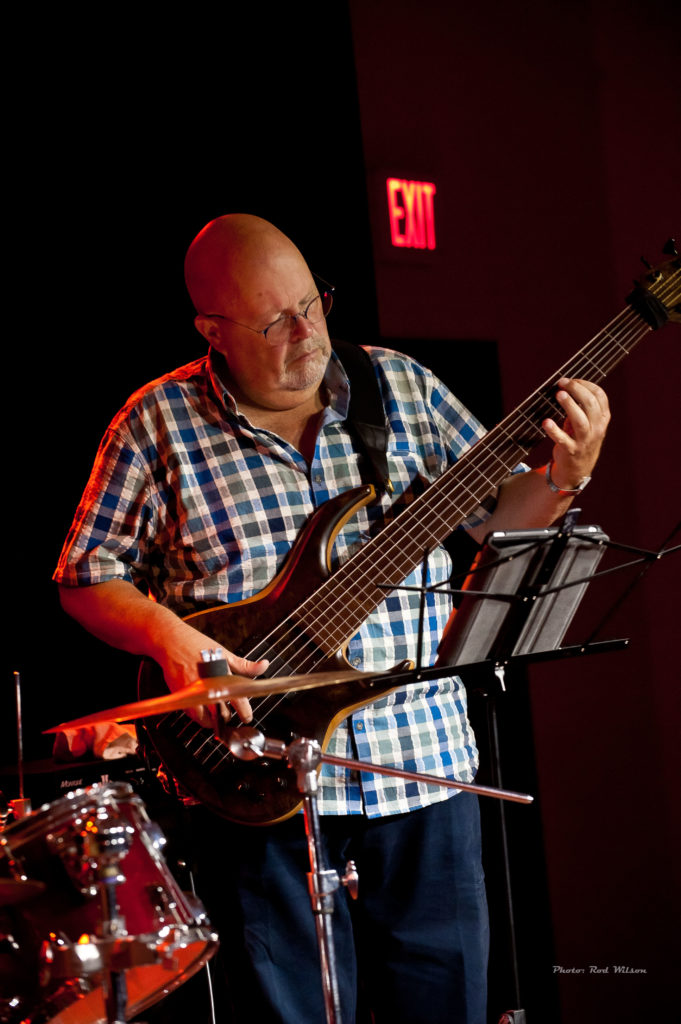

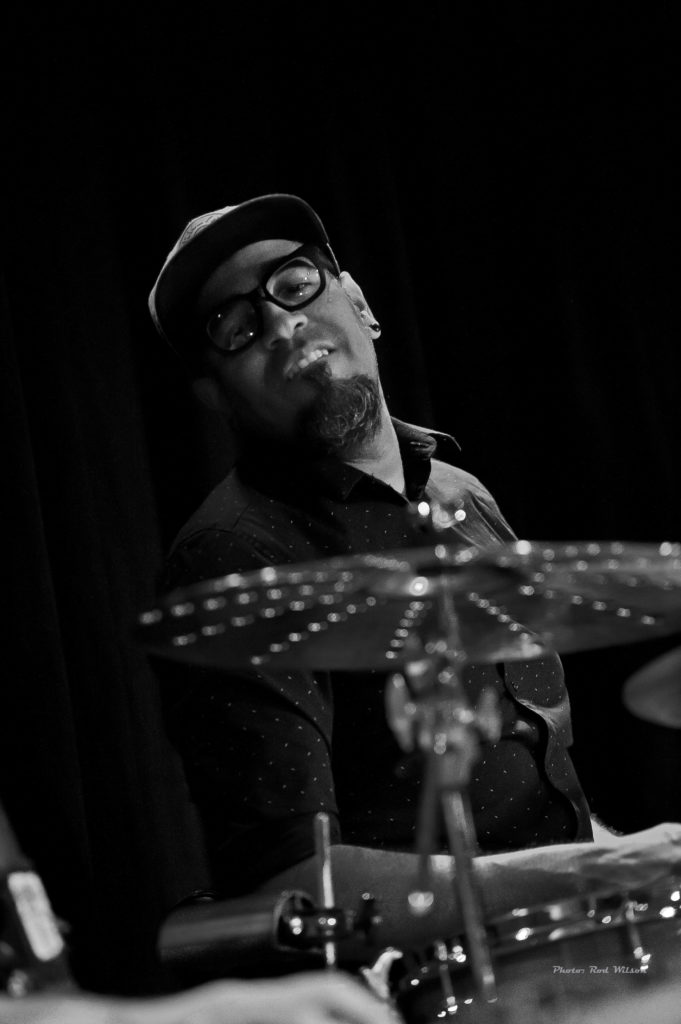
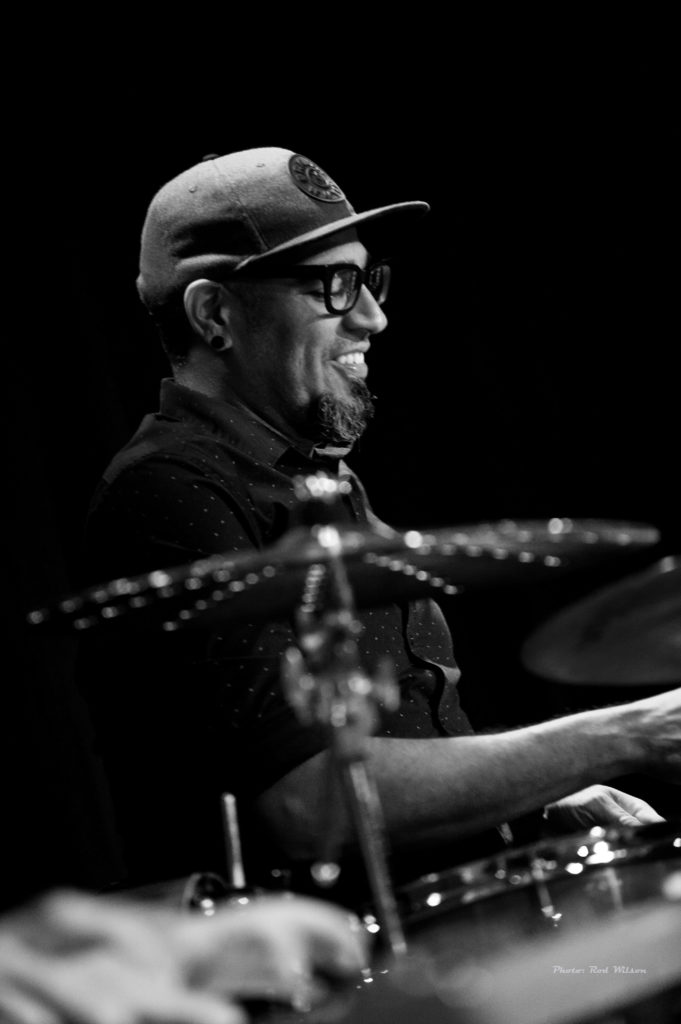
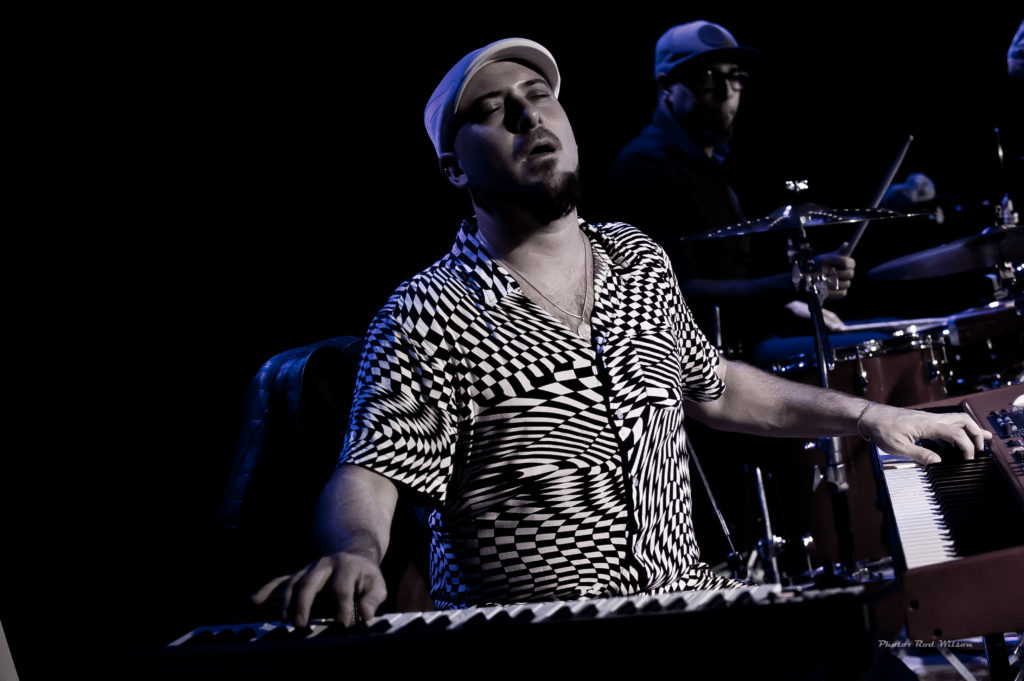

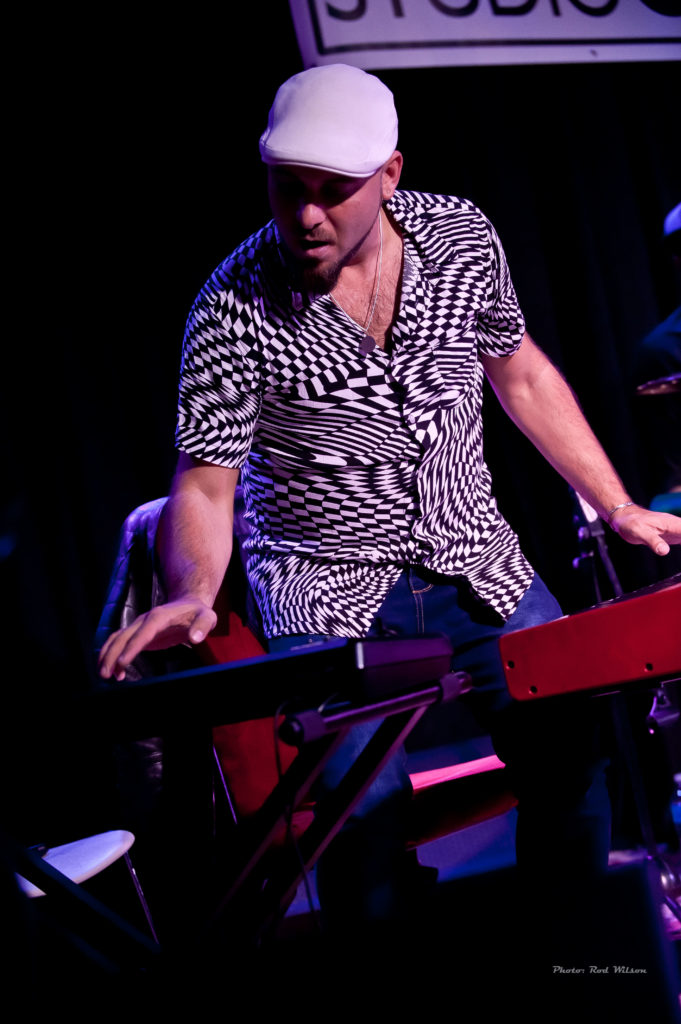

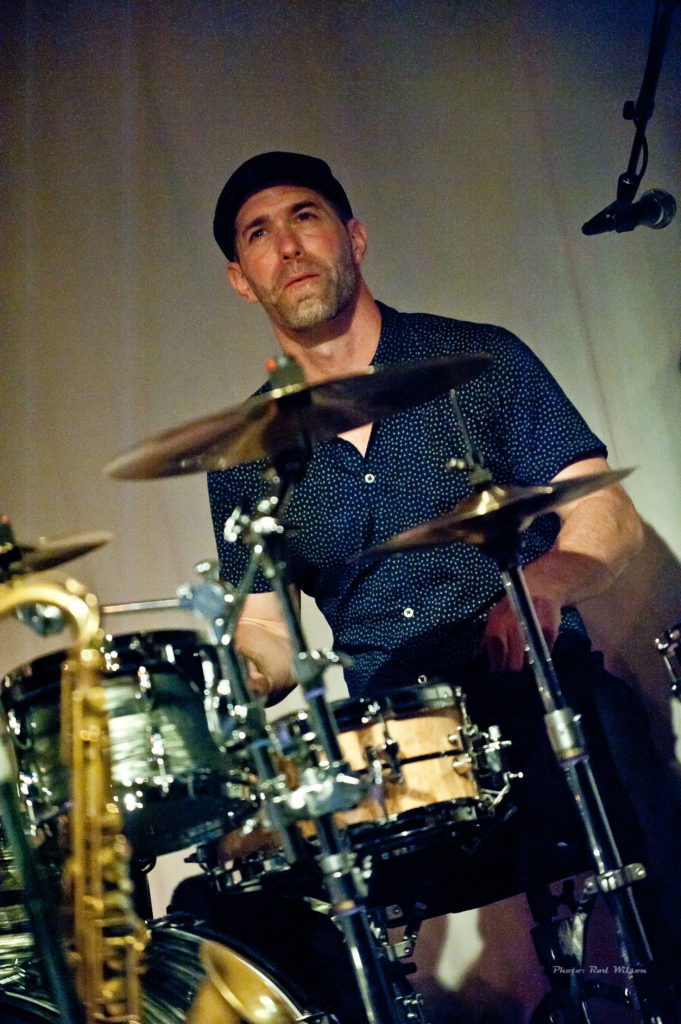
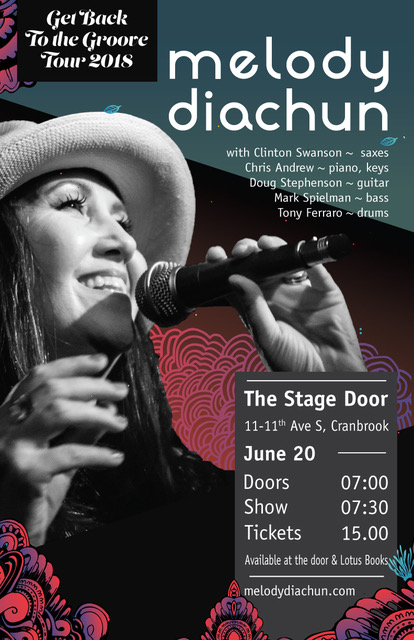
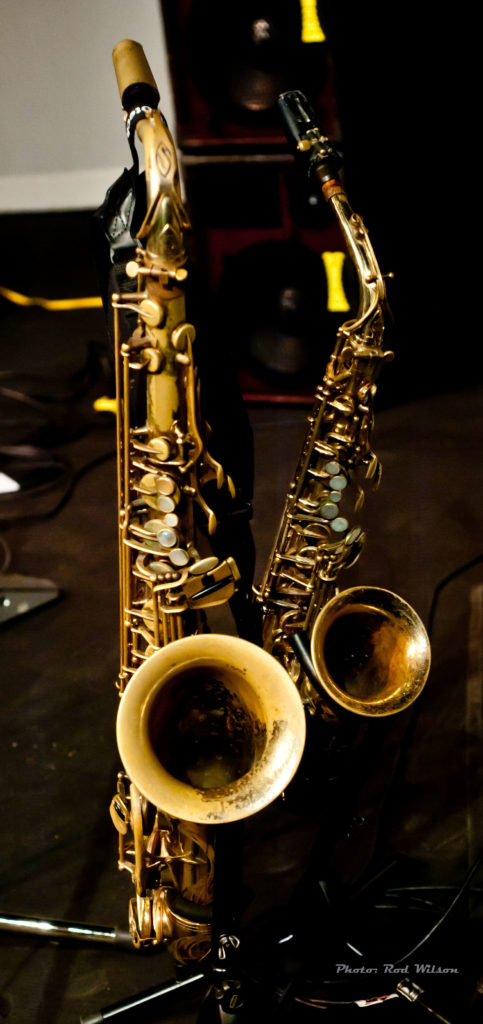 group of first class musicians that included Tony Ferraro on drums, Doug Stephenson on guitar, Mike Spielman on bass, Clinton Swanson on saxes and the Edmontonian Chris Andrew on keyboards. True to her promise of “getting back to the grove” she kicked off the evening with ZZ Top’s Sharp Dressed Man and an her own original Get Back to the Grove. What I like about the Stage Door as a venue is the opportunity to really hear the music. There are no impaired sight lines, no idle chatter or bar room clatter. It’s just about the music, the musicians and the the audience. The little nuances that might be easily passed over in other environs are there to be appreciated. When Melody picked up the shakers and beat out a groove Tony was right there behind her doubling the rhythm on his snare. The resulting pulse was mesmerizing. When Clinton Swanson rolled off the end of a solo guitarist Doug Stephenson was right there to pick it up and extend the melodic line that Clinton was exploring. And so on. The evening just rolled on with magical vocals and sparkling solos. Here are some more images from the evening:
group of first class musicians that included Tony Ferraro on drums, Doug Stephenson on guitar, Mike Spielman on bass, Clinton Swanson on saxes and the Edmontonian Chris Andrew on keyboards. True to her promise of “getting back to the grove” she kicked off the evening with ZZ Top’s Sharp Dressed Man and an her own original Get Back to the Grove. What I like about the Stage Door as a venue is the opportunity to really hear the music. There are no impaired sight lines, no idle chatter or bar room clatter. It’s just about the music, the musicians and the the audience. The little nuances that might be easily passed over in other environs are there to be appreciated. When Melody picked up the shakers and beat out a groove Tony was right there behind her doubling the rhythm on his snare. The resulting pulse was mesmerizing. When Clinton Swanson rolled off the end of a solo guitarist Doug Stephenson was right there to pick it up and extend the melodic line that Clinton was exploring. And so on. The evening just rolled on with magical vocals and sparkling solos. Here are some more images from the evening: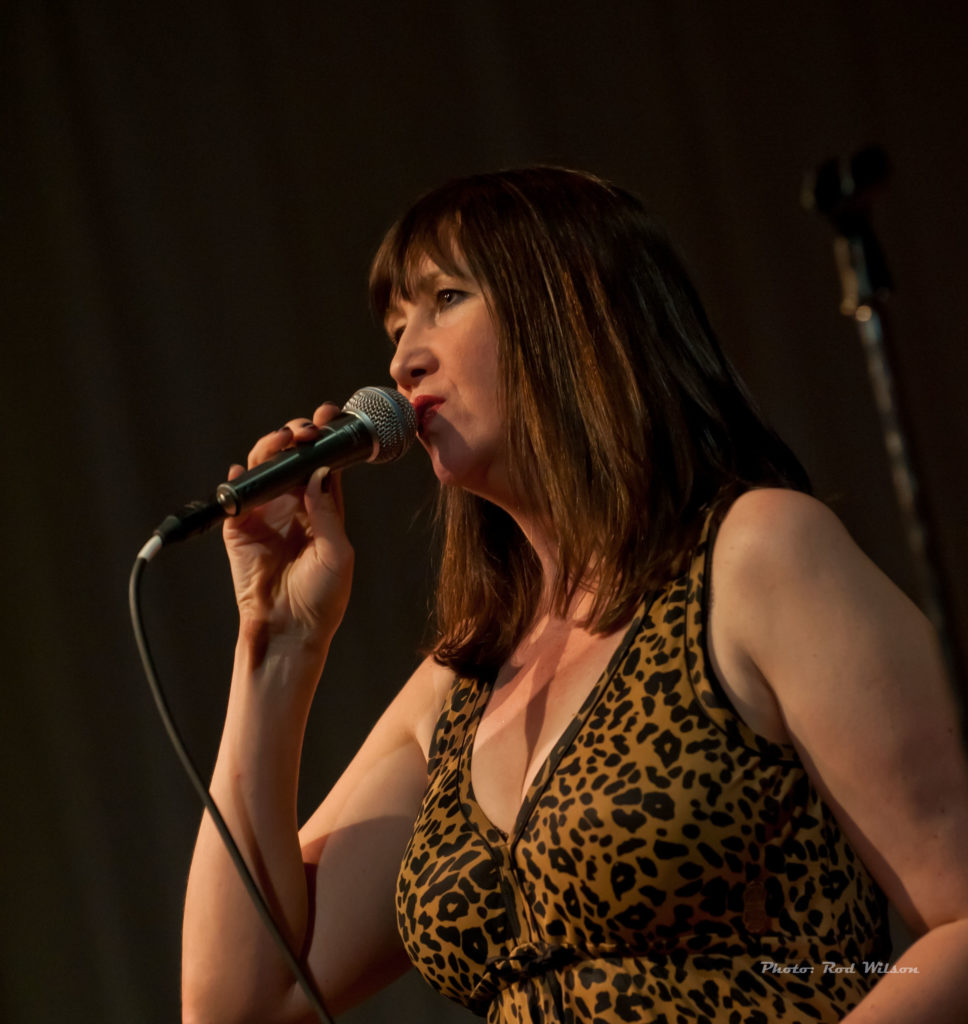
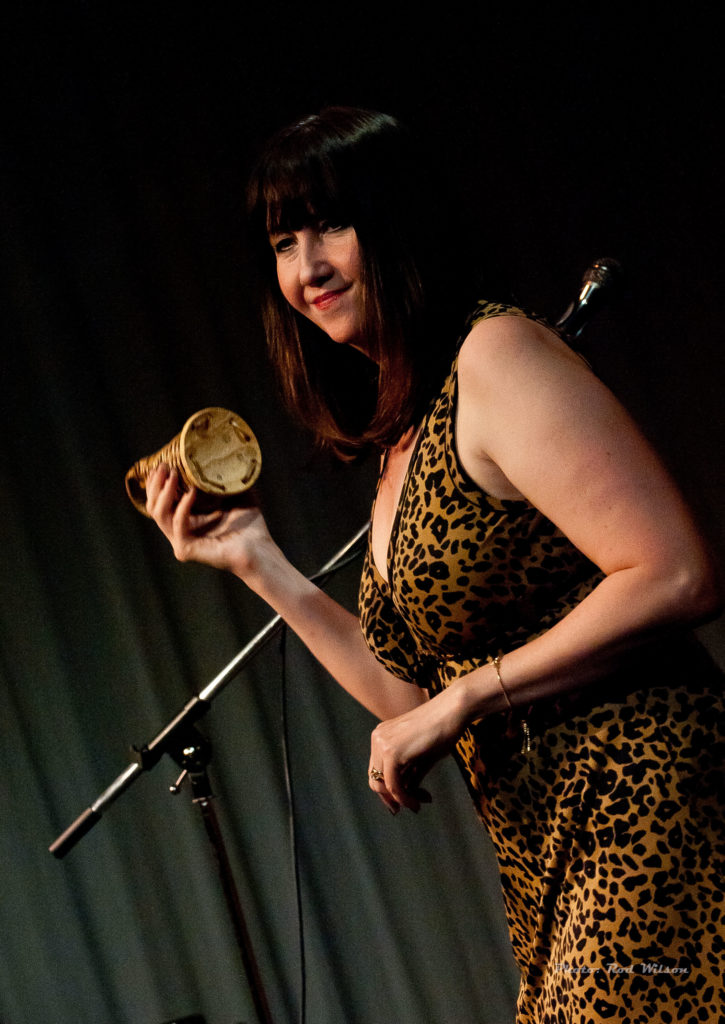

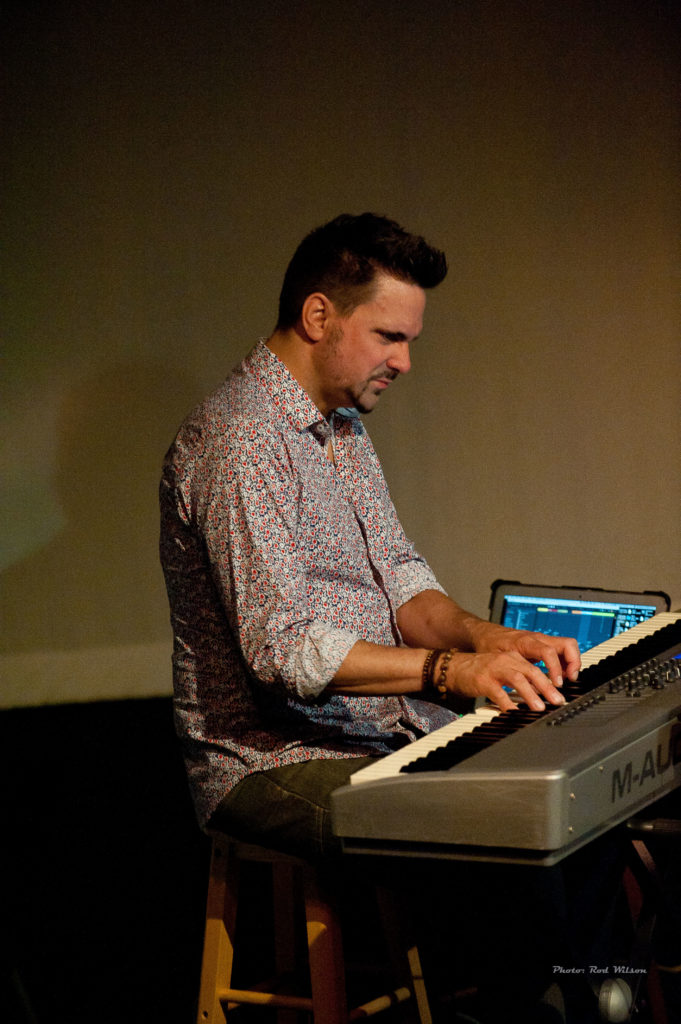
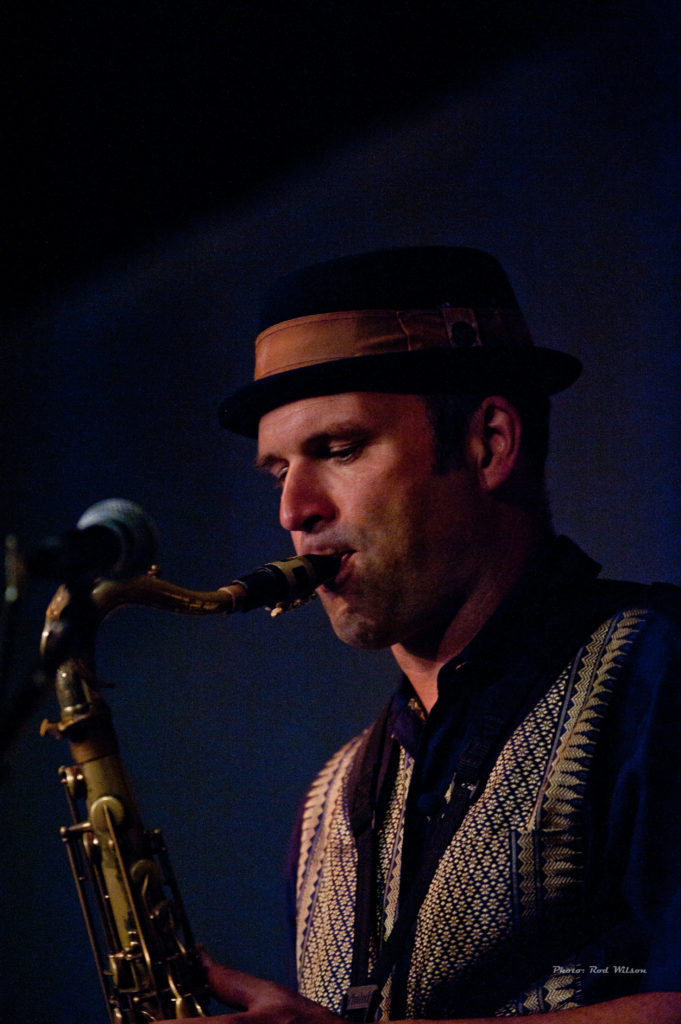
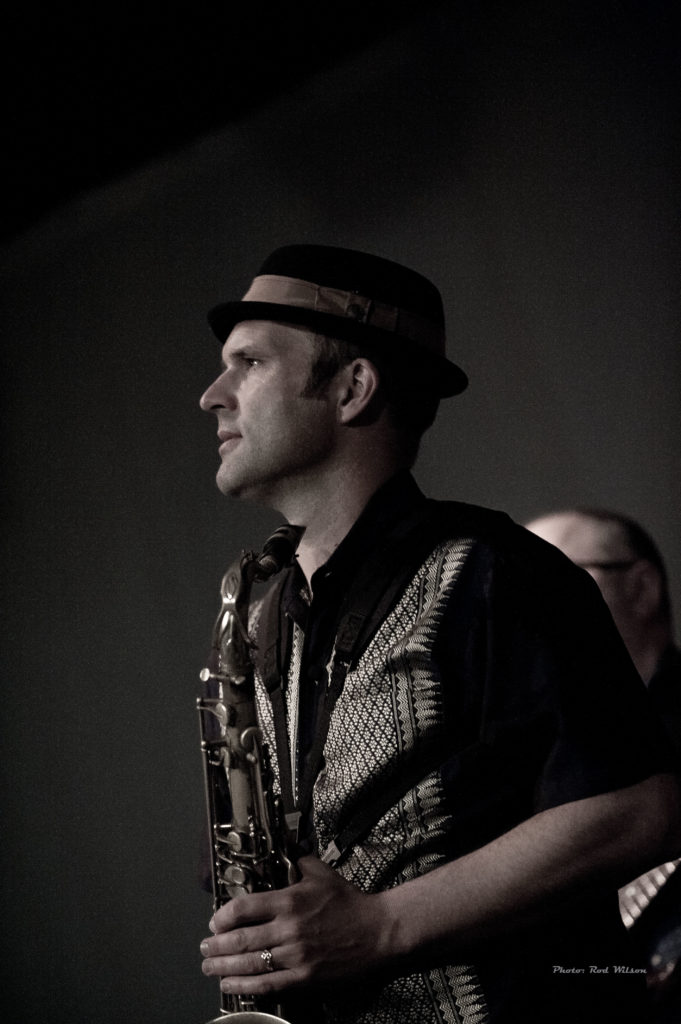
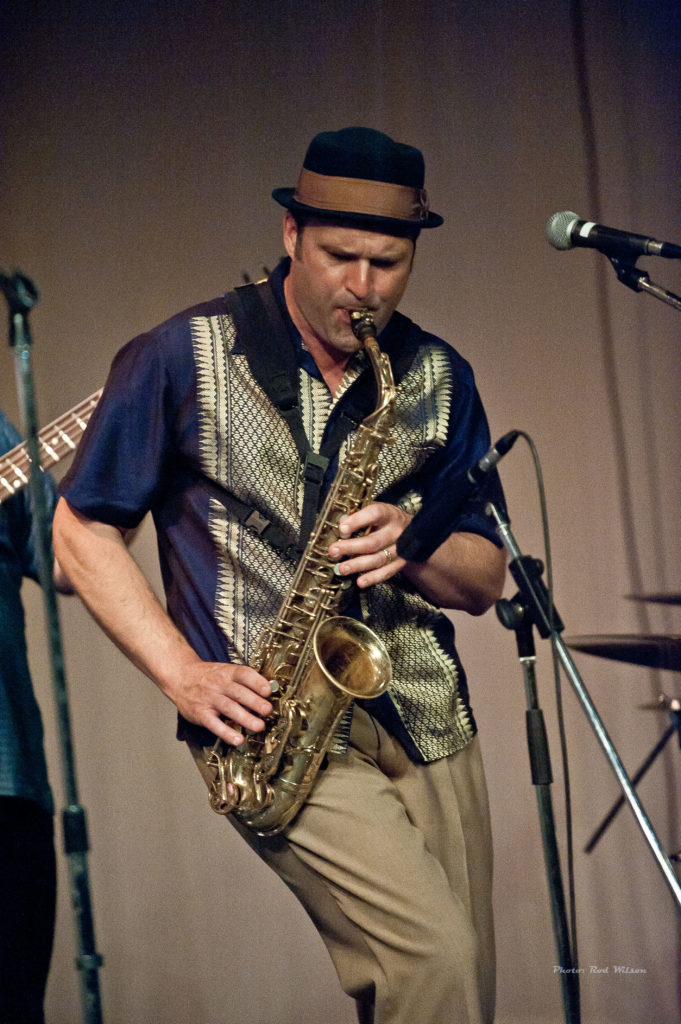

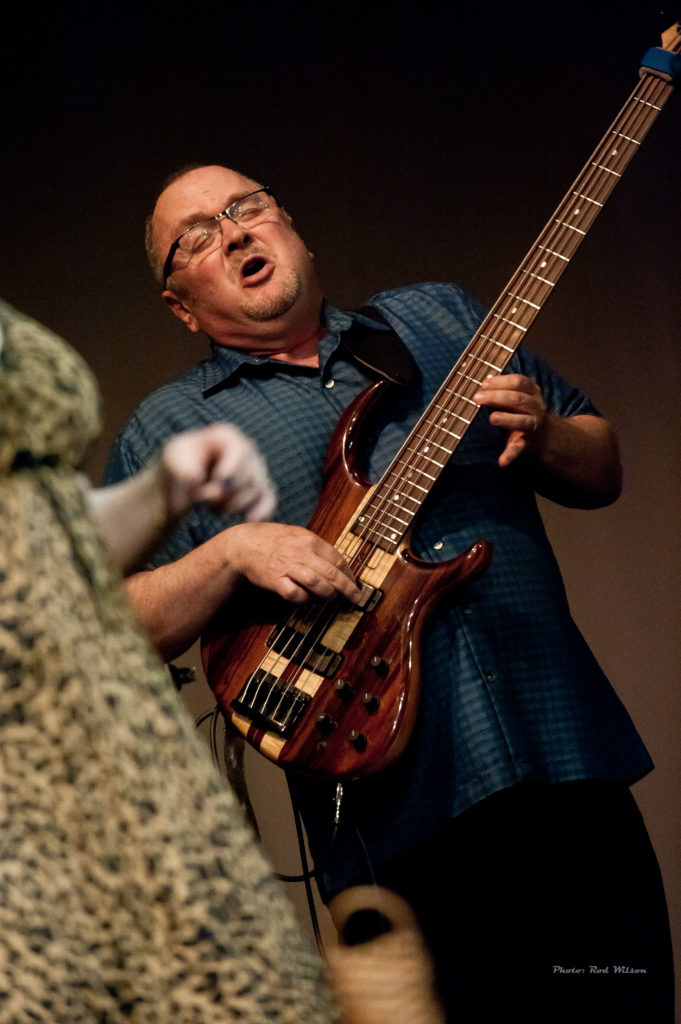
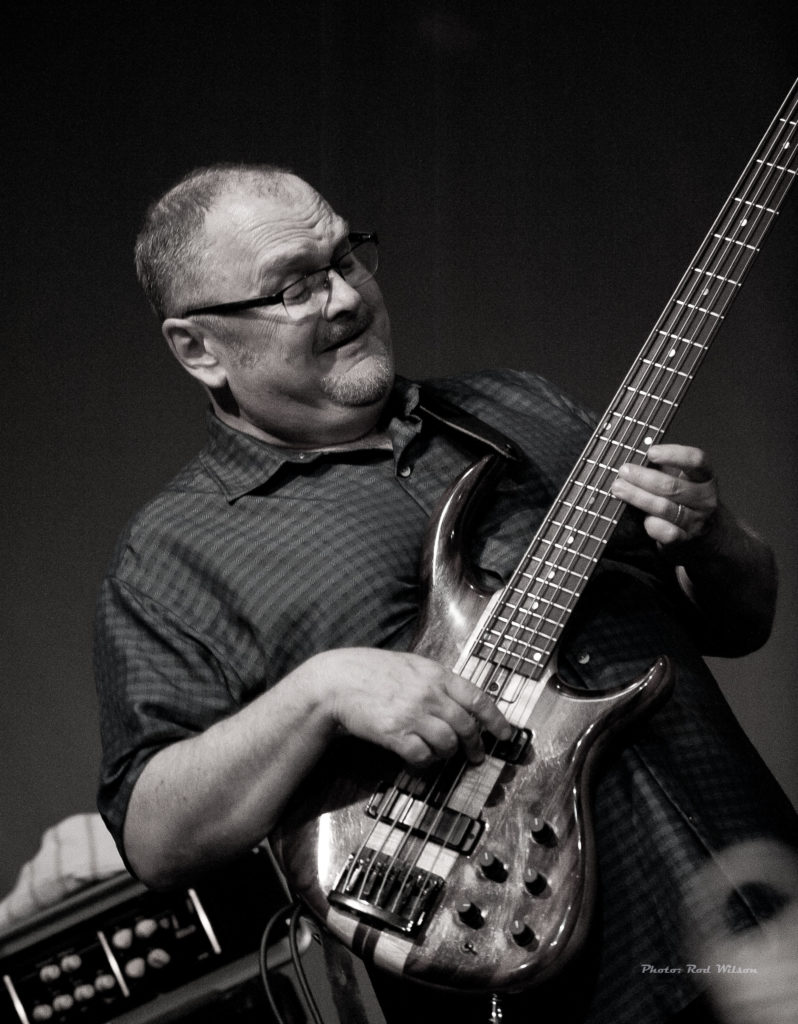
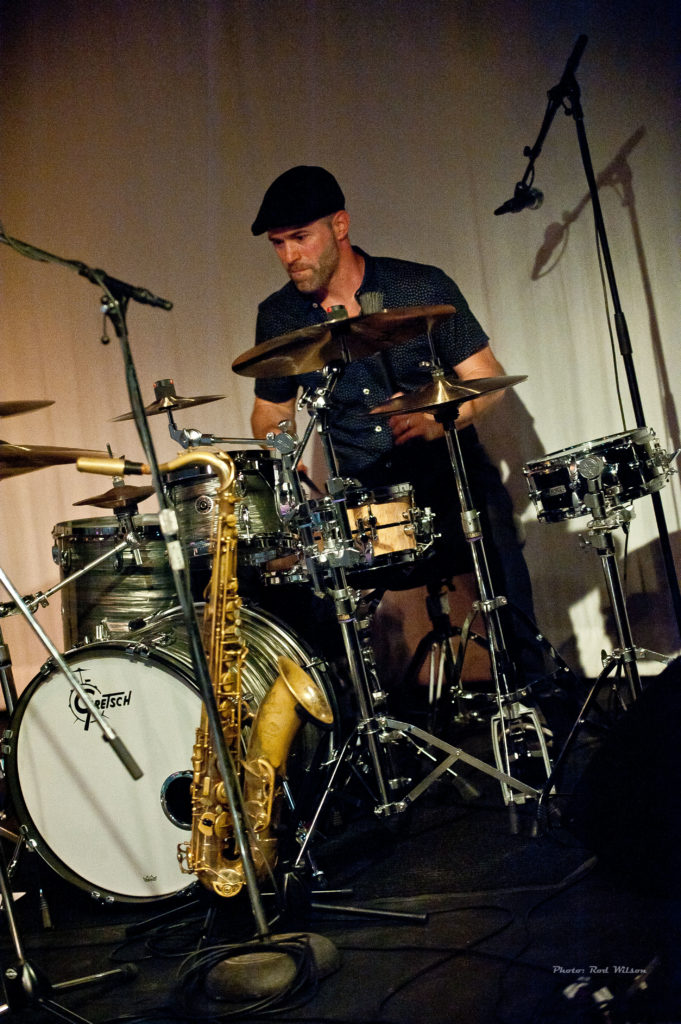
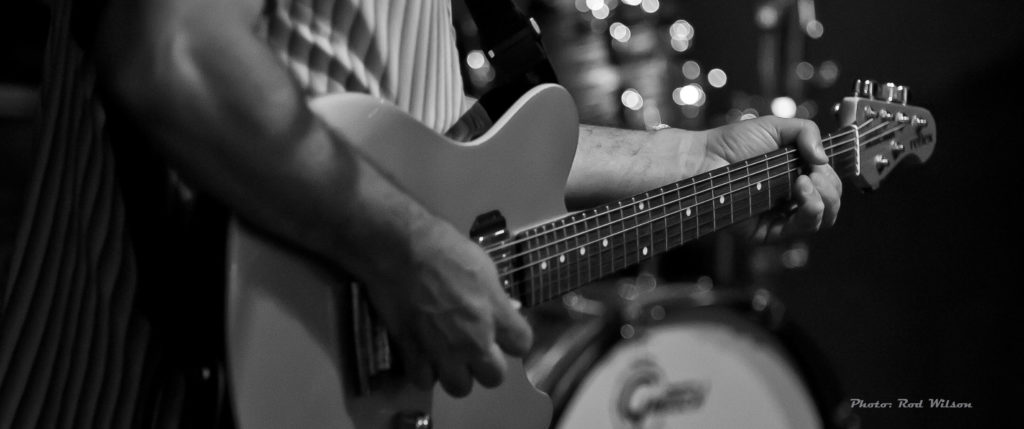
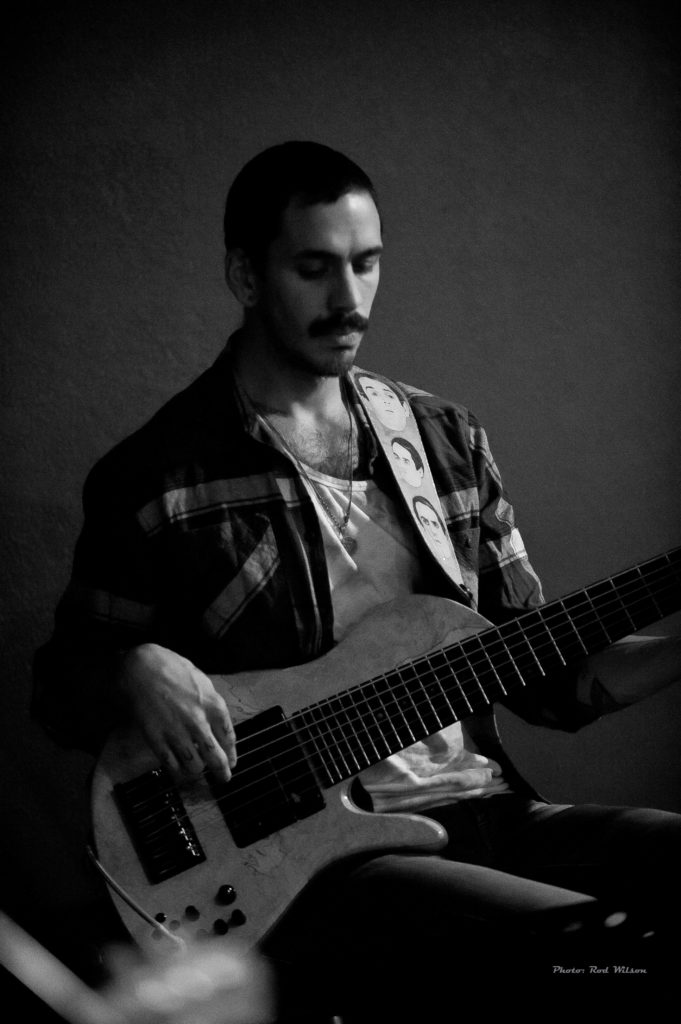 jazz performance. After it was over I begged to differ. It may have been masquerading as Soul and Funk but it was all jazz to me. Of course there were the Stevie Wonder, James Brown and Arethra Franklin hits and a sprinkling of Classic Rock (Drift Away and Harvest Moon). On a blues shuffle Michael Occhipinti did some romping around with his guitar set to an organ effect that made you look for the keyboard that wasn’t there. Lester played some searing alto sax solos and the giant in the back (Felix) played some blistering solos and backups on his Vinny Fodera six string bass. At one stage he was trading riffs with Michael that were over the top brilliant. This was an outstanding night of music.
jazz performance. After it was over I begged to differ. It may have been masquerading as Soul and Funk but it was all jazz to me. Of course there were the Stevie Wonder, James Brown and Arethra Franklin hits and a sprinkling of Classic Rock (Drift Away and Harvest Moon). On a blues shuffle Michael Occhipinti did some romping around with his guitar set to an organ effect that made you look for the keyboard that wasn’t there. Lester played some searing alto sax solos and the giant in the back (Felix) played some blistering solos and backups on his Vinny Fodera six string bass. At one stage he was trading riffs with Michael that were over the top brilliant. This was an outstanding night of music.